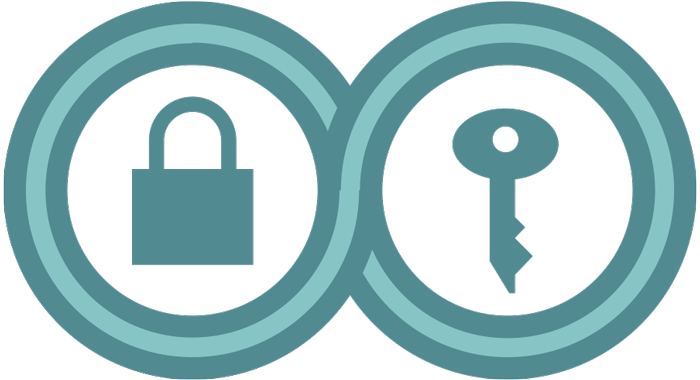如何加密 iPhone
最后更新: February 18, 2025
加密 iPhone 上的数据不仅仅是创建一个密码那么简单。很多数据可能是储存在线上的,因此一定要了解线上存储的原理,考虑启用额外的功能能来更好地保护这些数据。
如何在设备上加密数据
如果您有 iPhone 或 iPad,则可以使用加密来保护设备里的内容。这样,即使有人拿到了您的设备,还需要密码才能解密其中存储的内容,包括联系人、即时消息或短信、通话记录和电子邮件。
新款的苹果设备默认对其内容进行加密,保护级别取决于手机型号和手机当时的状态(例如有没有锁定或者是不是刚刚开机)。
要防止设备被盗后数据泄露,需要给加密设置一个只有自己知道的口令或密码。
根据苹果公司提供给执法部门的指南,启用密码之后,苹果公司无法协助执法部门提取信息:“对于运行 iOS 8.0 及更新版本的所有设备,苹果公司无法执行 iOS 设备数据提取,因为执法部门搜查的数据一般是加密的,而苹果公司没有加密密钥。所有 iPhone 6 及以后的设备型号出厂预装 iOS 8.0 或更新的 iOS 版本。”但是请注意,即使没有苹果公司协助,有些执法部门可能通过其他途径得到您手机里的数据。
在美国,使用生物识别技术(例如面容扫描或指纹)解锁手机可能会牺牲掉美国宪法第五修正案不得强迫自证其罪的规定赋予您的手机内容受法律保护的权利。根据现行美国法律(仍在不断变化中),使用记在脑中的密码在反对强制设备解锁/解密的法院命令时通常能得到更有力的法律支持。虽然 EFF 一直在努力加强针对强迫人们解密其设备的法律保护,但目前针对强制面部和指纹解锁的保护仍然不及针对强制披露密码的保护。
您可能在 iPhone 刚到手时设置了某种密码,但如果没有,或者您想更改设备的解锁方式,请前往 Settings > Face (or Touch) ID & Passcode(设置 > 面容(或触控) ID 与密码)。在这里,您可以设置解锁方式,或禁用生物识别登录而只用密码,方法是在“将面容(或触控)ID 用于:”下方取消选中“iPhone 解锁”选项。
您也可以更改手机使用的密码的要求。打开 Settings > Face (or Touch) ID & Passcode(设置 > 面容(或触控) ID 与密码),点击“Change Passcode”(更改密码)(如果您在首次设置手机时没有启用密码,则显示的是“Set Passcode”(设置密码))。当提示“Enter your new passcode”(输入新密码)时,点击“Passcode Options”(密码选项),在这里选择不同的数字长度或字母数字(同时包含字母和数字)密码。
如果出于任何原因,需要暂时阻止面容(或触控)ID 解锁 iPhone,不用进入设置菜单就能做到:
同时按住侧边按钮及任一音量按钮,直到关机滑块/紧急呼叫选项出现(无论手机当前是否锁定都可以)。如果点击“cancel”(取消),手机将要求输入密码来解锁。
如何加密 iCloud 数据
如果您使用苹果设备,那么您很可能至少将部分数据储存在苹果公司的云服务上,官方名称为 iCloud。这些数据可以包含多种信息,例如通讯录、应用程序文件和 iPhone 的完整备份。其中有些数据是默认端到端加密的——只有您有办法解密,苹果公司做不到,但有些不是。
苹果公司将其 iCloud 加密类型分为“标准数据保护”和“高级数据保护”。标准数据保护是默认启用的加密类型,而高级数据保护是一项可选设置,需要手动开启。
“标准数据加密”的含义
标准数据保护是指储存在 iCloud 上的很多数据通过苹果公司有权访问的加密密钥进行储存。来自您设备的加密密钥储存在苹果公司的服务器上,因此苹果公司能在需要时解密这些数据。这意味着,如果您忘记密码,苹果公司还能帮助您恢复密码。即使只是标准数据加密,有些数据还是会进行端对端加密,包括可能私密的信息,例如“手记”数据、“健康”数据、“钱包”凭证和您储存在内置密码管理器中的所有密码。
但是,标准数据加密不会端到端加密设备的 iCloud 备份或者“信息”对话的备份。也就是说,苹果公司可以获取加密密钥来解密可能敏感的数据。
“高级数据保护”的含义
对于启用标准数据保护时只在传输中和在苹果服务器上加密的数据,高级数据保护可以对它们进行端对端加密。换句话说,您现在可以控制加密密钥,苹果公司将无法访问这些数据。这也意味着苹果公司可能无法帮助您重新获得您账户的访问权限。高级数据保护涵盖很多重要信息,包括 iCloud 备份(包括“信息”的备份)、iCloud Drive、照片、备忘录、提醒事项以及下文表格详细列出的更多内容。
启用高级数据保护后,您的备份和最重要的文件将从端对端加密中受益,可更好地保护您的文件,不会受到大规模监控、被恶劣的苹果员工获取或发生潜在数据泄露。这么做的弊端是,如果您无法访问自己的账户或者丢失储存密钥的设备,苹果公司无法帮助您恢复这些数据。为了防止这种后果,苹果公司允许您创建一个恢复密钥(由您自己保存),或者您也可以指定您信任的人为恢复联系人,这个人会提供一个代码,来帮助您重新获得对您账户的访问权限。恢复联系人不能访问您的任何 iCloud 数据。
还是有一些类型的数据不在高级数据保护的范围之内。这些数据大多基于之前的标准构建,包括日历、通讯录和 iCloud 邮件。它们继续通过标准数据保护来储存。苹果公司在其提供给执法部门的指南中指出,苹果公司还收集一些关于备份、iCloud Drive 文件、照片、备忘录、书签和信息的元数据。
同样,不是所有使用 iCloud 来同步或备份数据的应用程序都支持高级数据保护,您需要直接联系应用程序的开发者,以明确应用程序储存数据的方式。这一点对于某些类型的应用程序可能比较重要,例如备忘录或手记应用程序,而对于其他应用程序(例如食谱储存应用程序)则不太重要。
如果数据通过高级数据保护储存,那么您的设备拥有解密该数据的密钥。如果通过标准数据保护来储存,那么苹果公司拥有密钥,这意味着该公司在技术上有能力自行解密该数据,可能包括为了响应执法部门的要求而解密。
iCloud 数据是端到端加密吗?
|
|
标准数据保护 |
高级数据保护 |
|
Apple Card 交易 |
✔️ |
✔️ |
|
日历 |
|
|
|
通讯录 |
|
|
|
无边记 |
|
✔️ |
|
“健康”数据 |
✔️ |
✔️ |
|
“家庭”数据 |
✔️ |
✔️ |
|
iCloud 备份 |
|
✔️ |
|
iCloud Drive |
|
✔️ |
|
iCloud 邮件 |
|
|
|
“手记”数据 |
✔️ |
✔️ |
|
地图 |
✔️ |
✔️ |
|
Memoji |
✔️ |
✔️ |
|
iCloud 云端信息 |
✔️ |
✔️ |
|
备忘录 |
|
✔️ |
|
密码和钥匙串 |
✔️ |
✔️ |
|
付款信息 |
✔️ |
✔️ |
|
照片 |
|
✔️ |
|
快速输入键盘学习的词汇 |
✔️ |
✔️ |
|
提醒事项 |
|
✔️ |
|
Safari 浏览器 |
✔️ |
✔️ |
|
Safari 浏览器书签 |
|
✔️ |
|
屏幕使用时间 |
✔️ |
✔️ |
|
Siri 信息 |
✔️ |
✔️ |
|
Siri 快捷指令 |
|
✔️ |
|
语音备忘录 |
|
✔️ |
|
W1 和 H1 蓝牙密钥 |
✔️ |
✔️ |
|
“钱包”凭证 |
|
✔️ |
|
无线局域网密码 |
✔️ |
✔️ |
共享或协作时的数据安全
如果您使用苹果公司的任何协作工具与他人共享数据,那么有几点关于端到端加密的事项需要考虑。
高级数据保护可使共享的内容保持端对端加密,前提是对方启用了高级数据保护。如果您有 iCloud Drive 共享文件夹、共享备忘录或使用 iCloud 共享照片图库,那么所有参与者都必须启用高级数据保护才能共享。例如,如果您有一个共享给他人的 iCloud 云盘文件夹,并且你们都启用了高级数据保护,那么该文件夹就会保持端到端加密。但是,共享文件时不会标注对方是否启用了高级数据保护,因此在共享重要文件之前,务必向对方确认。
然而,如果您使用任何类型的 iWork 协作,例如在 Pages 文稿或 Numbers 表格中与他人合作编辑一个文件,这些文件不会进行端对端加密。同样,如果您使用某个应用程序(如“文件”或“照片”)的“任何拥有链接的用户”选项来共享文件或文件夹,那么共享的内容将不再端到端加密。在这些情况下,采用标准数据保护。
如何启用高级数据保护
您可以从任何一台 iPhone、iPad 或 Mac 上启用高级数据保护,它将应用于您拥有的其他所有苹果设备。
但打开此功能之前,需要先做几件事:为您的苹果账户启用双重认证(如果之前没有启用)并更新所有苹果设备(至少更新到 iOS 16.3、iPadOS 16.3、macOS 13.2、tvOS 16.3、watchOS 9.3,在全球范围内可能需要使用更新版本的操作系统)。如果您有不能更新的旧设备连接到正在启用 ADP 的 iCloud 账户,您可能要暂时放弃启用高级数据保护。我们将在后文解释原因,并提供替代做法。如果您可以更新,请按照以下步骤打开端对端加密:
- 在 iPhone 或 iPad 上,打开 Settings (or System Settings on Mac) > "Your name" > iCloud > Advanced Data Protection > Account Recovery(设置(或 Mac 上的系统设置)>“您的姓名” > iCloud > 高级数据保护 > 账户恢复)。在这里,有两种恢复方式选项供您选择。这将帮助您重新获得账户的访问权限,因为苹果公司以后将无法做到这一点。您必须至少选择一种恢复方式,也可以两种都选:
- 恢复联系人:这是一位拥有苹果设备的朋友或家人,在您需要时,他们可以帮助您重新获得账户的访问权限。他们无法访问您的任何数据,但是可以给您发送一个能让您重新进入账户的恢复代码。未来如有需要,您可以从同样的菜单中删除此联系人。
- 恢复密钥:这是一串 28 个字符的代码,必要时您可以用它重新进入个人账户。苹果公司不会获得此密钥的副本,所以如果丢失了这个密钥,您可能永远失去苹果账户的访问权限。如果选择这种方法,您将需要多次输入密钥,所以请务必将它写下来。
- 回到 Settings (or System Settings on Mac) > "Your name" > iCloud Advanced Data Protection > Account Recovery(设置(或 Mac 上的系统设置)>“您的姓名” > iCloud > 高级数据保护 > 账户恢复)菜单,点选“Turn on Advanced Data Protection”(打开高级数据保护),然后按照提示操作。如果选择了这种恢复方式,您需要输入手机的 PIN 码和恢复密钥。
设置了高级数据保护之后,就不用再管它了,除非遇到以下情况:要设置发货时装有旧版操作系统的新设备(在这种情况下,您可能需要暂时禁用高级数据保护)、您需要进行账户恢复、或者需要从浏览器访问您的 iCloud 数据。如果您经常从 iCloud.com 访问数据,请进入 Settings > "Your name" > iCloud(设置>“您的姓名”> iCloud),点选 “Access iCloud Data on the Web”(在网页上访问 iCloud 数据),即可在需要时打开访问。
如果您有无法更新到 iOS 16.3 或更新版本的旧设备,那么只有从该设备上删除您的 Apple ID,才可以启用高级数据保护。在很多时候,这样做会导致设备不能再使用。例如,您有一台不能更新的旧 Apple TV,删除它您就不能用 Apple ID 访问 App Store,从而导致无法使用 Netflix、Hulu 和其他多种应用程序。苹果公司应改善这种现象,让人们在享受高级数据保护时,不必从旧设备上删除 Apple ID,即使这样会不能访问某些共享功能,如 iCloud Drive 或苹果照片。
不过,我们也不是无计可施。对于某些设备,如 Apple TV 或旧的 MacBook,解决这个问题的变通方法是创建第二个 Apple ID,然后在家人共享中将其指定为家人,这样就能转移您的许多订阅或 App Store 下载,但又不会授予该设备访问高级数据保护中涵盖的数据类型的权限。例如,您将无法访问照片库,但仍然可以访问通过苹果支付的 Netflix 订阅(如果您未通过苹果支付任何订阅,就完全不用操心了)。这个设置过程会比较繁琐。对于 Apple Watch 等严重依赖同步数据的设备,这个变通方法是行不通的。

